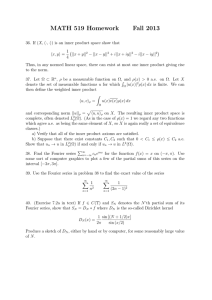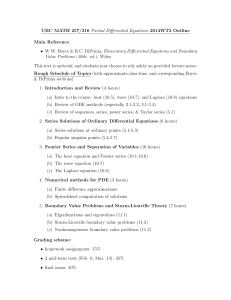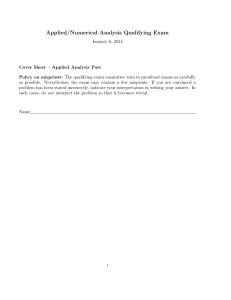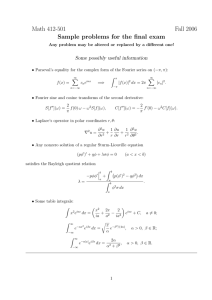Math 381 Fall 2006 Exam 2 Solutions Instructor: Sabin Cautis
advertisement
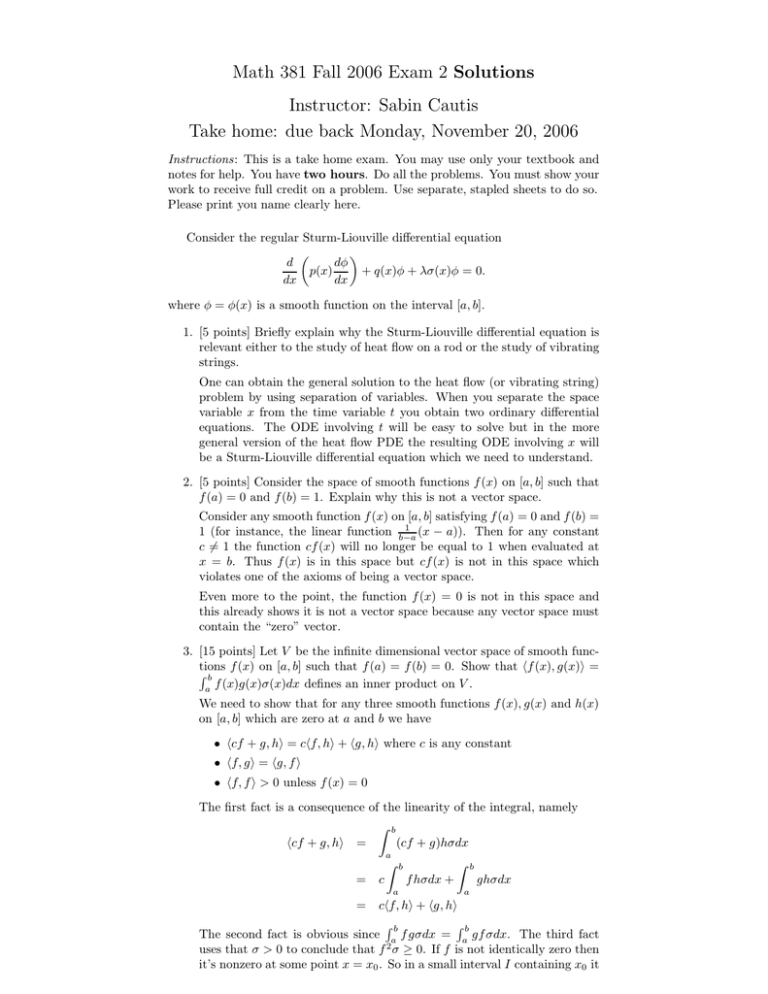
Math 381 Fall 2006 Exam 2 Solutions Instructor: Sabin Cautis Take home: due back Monday, November 20, 2006 Instructions: This is a take home exam. You may use only your textbook and notes for help. You have two hours. Do all the problems. You must show your work to receive full credit on a problem. Use separate, stapled sheets to do so. Please print you name clearly here. Consider the regular Sturm-Liouville differential equation dφ d p(x) + q(x)φ + λσ(x)φ = 0. dx dx where φ = φ(x) is a smooth function on the interval [a, b]. 1. [5 points] Briefly explain why the Sturm-Liouville differential equation is relevant either to the study of heat flow on a rod or the study of vibrating strings. One can obtain the general solution to the heat flow (or vibrating string) problem by using separation of variables. When you separate the space variable x from the time variable t you obtain two ordinary differential equations. The ODE involving t will be easy to solve but in the more general version of the heat flow PDE the resulting ODE involving x will be a Sturm-Liouville differential equation which we need to understand. 2. [5 points] Consider the space of smooth functions f (x) on [a, b] such that f (a) = 0 and f (b) = 1. Explain why this is not a vector space. Consider any smooth function f (x) on [a, b] satisfying f (a) = 0 and f (b) = 1 (x − a)). Then for any constant 1 (for instance, the linear function b−a c 6= 1 the function cf (x) will no longer be equal to 1 when evaluated at x = b. Thus f (x) is in this space but cf (x) is not in this space which violates one of the axioms of being a vector space. Even more to the point, the function f (x) = 0 is not in this space and this already shows it is not a vector space because any vector space must contain the “zero” vector. 3. [15 points] Let V be the infinite dimensional vector space of smooth functions f (x) on [a, b] such that f (a) = f (b) = 0. Show that hf (x), g(x)i = Rb f (x)g(x)σ(x)dx defines an inner product on V . a We need to show that for any three smooth functions f (x), g(x) and h(x) on [a, b] which are zero at a and b we have • hcf + g, hi = chf, hi + hg, hi where c is any constant • hf, gi = hg, f i • hf, f i > 0 unless f (x) = 0 The first fact is a consequence of the linearity of the integral, namely Z b hcf + g, hi = (cf + g)hσdx a = c Z a = b f hσdx + Z b ghσdx a chf, hi + hg, hi Rb Rb The second fact is obvious since a f gσdx = a gf σdx. The third fact uses that σ > 0 to conclude that f 2 σ ≥ 0. If f is not identically zero then it’s nonzero at some point x = x0 . So in a small interval I containing x0 it will also be nonzero (here we use that f is smooth and hence continuous). Thus f (x)2 σ(x) > 0 over I and hence hf, f i = Z b f 2 σdx ≥ Z f 2 σdx > 0. I a 4. [35 points] Let L be the linear differential operator on V defined by 1 dφ d L(φ) = p(x) + q(x)φ . σ(x) dx dx Show that L is self adjoint with respect to the inner product hf, gi = Rb a f gσdx. [Hint: use integration by parts like in the proof of Lagrange’s identity]. Let T be the linear operator T (φ) = σ(x)L(φ) = d dx dφ p(x) + q(x)φ . dx Lagranges’s identity states that for any smooth functions f, g Z n Z b T (f ) · gdx = f · T (g)dx a a Replacing T (f ) by L(f )σ(x) and T (g) by L(g)σ(x) gives Z b L(f )σ(x)gdx = a Z b f L(g)σ(x)dx a which proves that L is self-adjoint with respect to the inner product Rb hf, gi = a f gσdx. 5. [20 points] Assuming L as defined above is self adjoint show that two eigenfunctions φ1 and φ2 of L corresponding to different eigenvalues λ1 Rb and λ2 are orthogonal with respect to the inner product hf, gi = a f gσdx. By the hypothesis we know L(φ1 ) = λ1 φ1 and L(φ2 ) = λ2 φ2 . Also, since L is self-adjoint we know hL(φ1 ), φ2 i = hφ1 , L(φ2 )i. Substituting we get hλ1 φ1 , φ2 i = hφ1 , λ2 φ2 i from which it follows λ1 hφ1 , φ2 i = λ2 hφ1 , φ2 i. Since λ1 6= λ2 this means hφ1 , φ2 i = 0. 6. [15 points] Denote the eigenfunctions of L by φ1 (x), φ2 (x), . . . and let f (x) be a smooth P∞ function on [a, b]. Determine the generalized Fourier series f (x) ∼ n=1 an φn (x) of f (x) (ie. determine the generalized Fourier coefficients an ). We know that hφi (x), φj (x)i = 0 if i 6= j since any two eigenfunctions corresponding to different P∞ eigenvalues are orthogonal. Thus, if we take the inner product of n=1 an φn (x) with φi we get h ∞ X an φn (x), φi (x)i = n=1 ∞ X an hφn , φi i n=1 = ai hφi , φi i Thus hf, φi i = ai 6 φi , φi i from which we get that the generalized Fourier coefficient ai is given by hf, φi i . ai = hφi , φi i 7. [5 points] If f (x) is smooth on [a, b] is it equal to its generalized Fourier series from the previous question? Give an example of a function on [a, b] (not necessarily continuous) whose generalized Fourier series is not equal to it (explain why not). Let x = x0 ∈ (a, b) be any point and f any function discontinuous at x0 . Then the generalized Fourier series at x = x0 converges to ! 1 y0 = lim f (x) + lim+ f (x) 2 x→x− x→x0 0 so that if we define f (x0 ) to be anything other than y0 then the generalized Fourier series and the function f (x) will be different. Along similar lines, you could also choose a function on [a, b] whose periodic extension is discontinuous at a or b (in a way this is the same example as above where you choose x0 to be either a or b).


